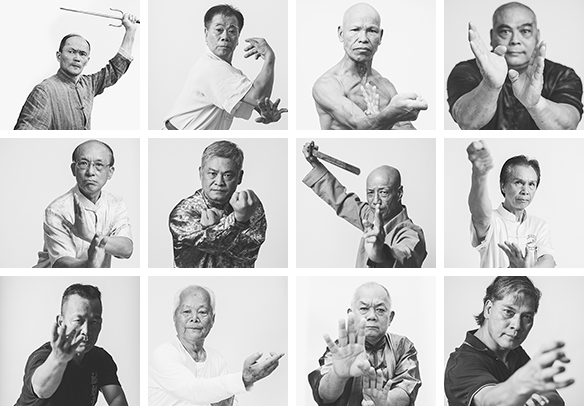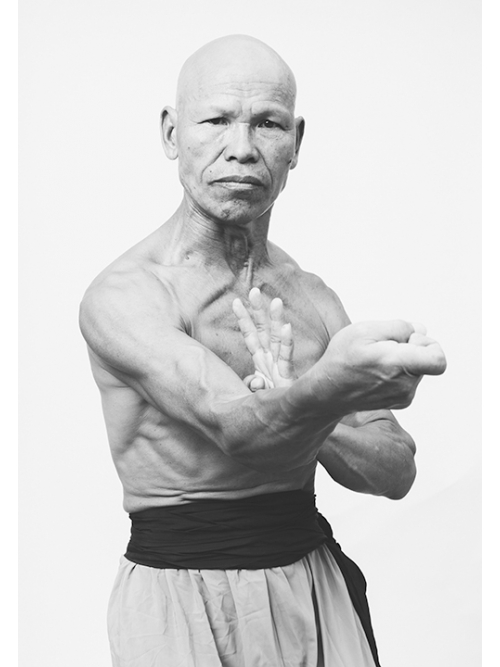Yau Wan Wah, Hakka, was born in Hong Kong in 1954 and is a native of Baitang village in Boluo county, Guangdong province. He is the eldest in his family and worked at the Agriculture, Fisheries and Conservation Department before retirement. He grew up in Tong Hang village in Fanling, and developed a strong interest in the martial arts through watching kung fu films and because his natural love for physical exercise. From 1967 to 1969 Chan Kam sifu, a master of Chu Gar Praying Mantis, ran a school in his village. Yau Wan Wah studied there for several months in 1969, but Chen sifu soon left Tong Hang village so he only had time to learn some basic stances. In 1972 he went to study Pak Mei at Chan Kwok Wah’s school at Fanling No. One Bridge, which lasted a year.
丘運華,客家人,1954年香港出生,籍貫廣東省博羅柏塘,家中長兄,已退休,前漁農處職員。自小在粉嶺塘坑村居住,年少時喜愛觀欣武打電影,又熱衷於鍛練身體,因此一直想學功夫。1967至1969年村內有位陳金師傅教朱家螳螂,於是丘運華1969年學了幾個月,只練了馬步,陳師傅後就離開了塘坑村。1972年,他到粉嶺一號橋的陳國華的武館,學白眉派功夫,練了一年。
In 1973 a friend in the village recommended Yau Wan Wah to study Iron Ox Praying Mantis with Lai Yan sifu at Tai Po Wah Chau Calisthenics School. Tuition was thirty Hong Kong dollars per month, and he needed to bring his own incense for the formal initiation ceremony. The school was on the fourth floor of Tai Po Ching Fat Building (the building still exists today). There was a group of over ten students and they continued to meet regularly to this day. Lai Yan seldom spoke to the students about the origin of Iron Ox Praying Mantis, and Yau Wan Wah did not even know about its founder Choy Tit Ngau until meeting Li Tin Loy of Tung Kong Chow Ka Preying Mantis.
1973年,村中有位人朋友知道丘運華喜歡學功夫,介紹他到大埔惠州健身學院,跟隨黎仁師傅學鐵牛螳螂。當時學費每月需要三十元,需自備香燭拜師。武館在大埔正發樓四樓,現時大廈還在。有十多位師兄弟一起練武,現時仍然保持聯系及時常聚會。黎仁甚少跟徒弟談及鐵牛螳螂的源流。後來從東江周家螳螂拳李天來知道鐵牛螳螂拳由蔡鐵牛創。
According to a report in New Martial Hero magazine (August 1973), Yau Wan Wah’s grand teacher Lai Chung Mun inherited the teachings from Tse Kwok Yun. What he knows is that his master came from Huitung and moved to Hong Kong in the 1960s. At first he lived in Lin Ma Hang in the Northern District in the New Territories, and later taught martial arts and practiced traditional healing in Nga Yiu Tau and Sheung Shui. He had a clinic in San Hong Street in Sheung Shui but it closed after his death. He still has a son living in Tin Ping Estate in Sheung Shui. In the 1970s Yau Wan Wah took part in many martial art activities with his master Lai Yan, and attended gatherings organized by famous Hakka masters such as Chu Goon Wah and Chu Goon Wong (both celebrated masters of Chu Gar Praying Mantis, deceased). They were also invited to attend the opening of various institutions such as Lamma Island Wai Chow School, Sheung Shui Wai Chow School, etc., where they performed unicorn dance and kung fu. During Chinese New Year it was customary to perform the full hoi pang(Kung Fu and Unicorn Dance) ceremony, which always begins with unicorn dance and is followed by kung fu performance. On the second day of the New Year they performed unicorn dance in the streets of Tai Po, and conveyed propitious greetings to the shops and walled (Hakka) villages of the neighbourhood.
丘運華的師公賴總滿,師從謝國源(1973年8月新武俠雜誌報道,李天來提供資料)。丘運華知道師傅是惠東人,1960年代到香港,早期在新界北區蓮麻坑,瓦瑤頭、上水等地教功夫及行醫。曾在上水新康街設有醫館,但過世後關閉了,有一兒子在上水天平邨居住。1970年代,丘運華常常跟隨黎仁參與武林界的活動,如朱冠華(朱家螳螂及周家螳螂拳名師,已故)、朱冠煌(朱家螳螂名師,朱冠華的弟弟,已故)等前輩的宴會。不同地方的開幕儀式,如南丫島惠州學校、上水惠州學校開張等,他們受邀請到賀,表演麒麟及功夫。新年開棚(先舞麒麟之後表演功夫),年初二在大埔區街道上舞麒麟,跟店鋪拜年,到村拜年等。
In 1978 Yau began work with the Agriculture, Fisheries and Conservation Department and was permanently stationed in the hills of the Northern District, such as Pat Sin Leng and Wu Tip Shan. Beside kung fu practice he started to train in cross-country running as he wanted to push himself to the physical limit. In 1986 he took part in the fifth Trail Walker competition, and completed the race within twenty hours, winning first prize among the civil servants. In addition, he has taken part in many long distance and cross-country races including the Hong Kong Marathon, Shui Tong Cup, etc., and has won many prizes.
在1978年任職漁農處職員,長期註守北區的山嶺,如八仙嶺,蝴蝶山等,他除了練功夫之外,亦開始練習野外跑步,不斷挑戰自己的體能極限。1986年參與第五屆毅行者 ,以近二十小時完成比賽(勇奪政府部門第一名),亦不時參加各種馬拉松、水塘杯等不同類型的競跑比賽,屢獲殊榮。
Yau Wan Wah followed his master Lai Yan for thirty years until his passing, when the site for the school was taken back by the landlord. Between 1973 and 1993 he went to the school to train three evenings every week. From 1980 to 1990 the school was run by his elder martial art brother, Kong Chi Keung. There were around twenty students in regular attendance, and on occasions when the elder brother was unavailable he was responsible for teaching. In 1986 Yau taught a number of village children in Tong Hang village but they have since lost contact. He still teaches at the village rural committe but there are only a handful of students.
丘運華跟隨黎仁習武三十年,直到師過世,武館被業主收回為止。從1973年至到1993年,每星期到武館三晚練功。1980年至1990年期間,武館主要由大師兄(江志強)執教,仍保持二十多名學員,如大師兄不在武館,他就幫忙指導師弟們。丘運華1986年曾經在塘坑村教過一些小朋友,但都沒有聯系了,現時亦有在村公所教村中子弟,但人數較少。
Iron Ox Praying Mantis has many defensive hand techniques, which in martial arts parlance are at once strict and dense. Yau Wan Wah is the only one among his martial art brothers to teach kung fu, and he wishes to teach as many students as possible. In 2015 he co-founded Hakka Kung Fu Culture Research Society and was elected deputy president.
鐵牛護身技術多,防守手法嚴密。師兄弟中只有丘運華一個仍有教功夫,如有機會,他願意花時間多教學生。2015年丘運華為客家功夫文化研究會創會成員之一,任副主席。





